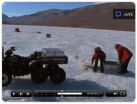(Press-News.org) Lake Bonney in Antarctica is perennially covered in ice. It is exposed to severe environmental stresses, including minimal nutrients, low temperatures, extreme shade, and, during the winter, 24-hour darkness. But, for the single-celled organisms that live there, the lake is home. To study them, Dr. Rachel Morgan-Kiss from the University of Miami, Ohio, and her team went to Antarctica to sample the ice-covered lake. The article describing her method will be published April 20, in the JoVE (the Journal of Visualized Experiments).
"Our laboratory has a focus on understanding adaptations in extreme environments," said Dr. Morgan-Kiss. "Ice-covered lakes are much simpler to study than typical aquatic environments because all of the organisms in the lake are microbial. They are at both the top and the bottom of the food chain."
Despite being microscopic, these organisms may play a big role in global climate change. Many of them have a mixotrophic metabolism, meaning that they survive either by fixing carbon, like plants, or by eating other protists (single-celled microbial eukaryotes). However, it's not known what causes these organisms to display one type of metabolism over another.
Moreover, it is not known how the climate effects this metabolic switch. If climate change causes more episodic weather events (like storms), nutrients will be stirred up from the bottom of lakes and oceans. This could have a huge impact on protist metabolism and climate change overall.
To help answer this question, Dr. Morgan-Kiss and her team took samples from different parts of the lake— the top, middle, and bottom— where the nutrient to sunlight ratios in the lake vary. The top gets plenty of sunlight, but there are few nutrients; the middle of the lake has moderate amounts of both; and the bottom gets little sunlight but is nutrient-rich.
"This interesting video-article produced by the JoVE Video team helps show exactly how scientists navigate in this challenging environment" says Dr. Beth Hovey, JoVE Editorial Director. "Research in Antarctica can add a great deal of insight in the realm of climate change. By opening a window into how to conduct science in extreme environments, Dr. Morgan-Kiss and her colleagues are helping advance this field of study."
INFORMATION:
Research on carbon-consuming life-forms in Antarctica published in JoVE
Journal demonstrates novel procedure in Antarcitca
2012-04-24
ELSE PRESS RELEASES FROM THIS DATE:
First fruitful, then futile: Ammonites or the boon and bane of many offspring
2012-04-24
For 300 million years, they were the ultimate survivors. They successfully negotiated three mass extinctions, only to die out eventually at the end of the Cretaceous along with the dinosaurs: Ammonoids, or ammonites as they are also known, were marine cephalopods believed to be related to today's squid and nautiloids. Ammonoids changed their reproductive strategy early on in the course of evolution. However, what was once a successful initial strategy may well have proved to be a fatal boomerang at the end of the Cretaceous, as an international team of researchers headed ...
A matter of priorities
2012-04-24
Just as banks store away only the most valuable possessions in the most secure safes, cells prioritise which genes they guard most closely, researchers at the European Molecular Biology Laboratory's European Bioinformatics Institute (EMBL-EBI) have found. The study, published online today in Nature, shows that bacteria have evolved a mechanism that protects important genes from random mutation, effectively reducing the risk of self-destruction. The findings answer a question that has been under debate for half a century and provide insights into how disease-causing mutations ...
Warwick researchers solve 40-year-old Fourier Transform Mass Spectrometry phasing problem
2012-04-24
Scientists at the University of Warwick have developed a computation which simultaneously doubles the resolution, sensitivity and mass accuracy of Fourier Transform Mass Spectrometry (FTMS) at no extra cost.
Researchers in the University's Department of Chemistry have solved the 40-year-old phasing problem which allows plotting of spectra in absorption mode.
This breakthrough can be used in all FTMS including FT-ICR, Orbitrap and FT-TOF instruments and will have applications in proteomics, petroleum analysis, metabolomics and pharmaceutical analysis among other fields.
Professor ...
Cranfill Sumner & Hartzog LLP Welcomes Ginny Allen to Head Business Development
2012-04-24
Cranfill Sumner & Hartzog LLP (www.cshlaw.com), a North Carolina defense litigation firm based in Raleigh, recently added Ginny Allen to its Raleigh office to serve as the firm's Chief Business Development Officer. Allen's experience as a practicing attorney as well as her experience in legal services marketing and business development in North Carolina makes her a significant addition to the firm.
"Ginny brings the type of charismatic and experienced personality we wanted to manage our business development activities," said Dan Hartzog, Cranfill Sumner ...
Online tool can detect patterns in US election news coverage
2012-04-24
The US presidential election dominates the global media every four years, with news articles, which are carefully analysed by commentators and campaign strategists, playing a major role in shaping voter opinion. Academics have developed an online tool, Election Watch, which analyses the content of news about the US election by the international media.
A paper about the project by academics at the University of Bristol's Intelligent Systems Laboratory will be presented at 13th conference of the European Chapter of the Association for Computational Linguistics held in ...
How the ecological risks of extended bioenergy production can be reduced
2012-04-24
This press release is available in German.
Jena/Leipzig. For years experts have discussed the ecological impact of the extended cultivation of energy crops. Scientists have now developed a computer model that allows assessing the impacts and comparing the effectiveness of strategies for the reduction of risks for biological diversity. Conclusion: The extension of bioenergy leads to problems to biological diversity in agrarian regions. With different accompanying measures, such as the conservation of near-nature areas, however, these effects could be partly reduced, as ...
Study reveals how ancient viruses became genomic 'superspreaders'
2012-04-24
Scientists have uncovered clues as to how our genomes became riddled with viruses. The study, supported by the Wellcome Trust, reveals important information about the so–called 'dark matter' of our genome.
For years scientists have been struggling with the enigma that more than 90 percent of every mammal's genome has no known function. A part of this 'dark matter' of genetic material is known to harbour pieces of DNA from ancient viruses that infected our ancestors going back as far as the age of the dinosaurs.
Researchers at Oxford University, the Aaron Diamond AIDS ...
Olympic boxing may damage the brain
2012-04-24
Olympic boxers can exhibit changes in brain fluids after bouts, which indicates nerve cell damage. This is shown in a study of 30 top-level Swedish boxers that was conducted at the Sahlgrenska Academy at the University of Gothenburg, Sweden, in collaboration with the Swedish Boxing Federation, published in PLoS ONE.
It has been debated for quite some time whether Olympic boxing (amateur boxing) is hazardous to the brain. Researchers at the Sahlgrenska Academy, Gothenburg University, joined with colleagues at the Faculty of Health Sciences at Linköping University and ...
Scientists have discovered genes that increase the risk of osteoporosis and fractures
2012-04-24
Researchers at the Sahlgrenska Academy at the University of Gothenburg, Sweden, have identified the genetic variations that are believed to cause osteoporosis. The study, published in Nature Genetics and involving leading researchers from Sweden and the world, shows among other interesting facts that women with a higher proportion of genetic variations associated with osteoporosis have a more than 50 percent increased fracture risk.
Osteoporosis is a common and a devastating age-related disease about 50 percent of all who have a hip fracture after age 80 die within one ...
2 distinguishable gene groups detected: 1 'normal' and 1 problematic
2012-04-24
Jerusalem, April 23, 2012 – Researchers at the Hebrew University of Jerusalem and other institutions have identified two distinguishable groups of genes: those that produce very abundant biochemical products in the cell and function properly in the majority of biological processes, and a flexible subset that might have abnormal function in a disease.
They demonstrated that these two groups can be found among various organisms and cell types, including stem cells and cancer cells.
One set of genes is a robust network that conducts the basic functions of all cells, ...
LAST 30 PRESS RELEASES:
The Ceramic Society of Japan’s Oxoate Ceramics Research Association launches new international book project
Heart-brain connection: international study reveals the role of the vagus nerve in keeping the heart young
Researchers identify Rb1 as a predictive biomarker for a new therapeutic strategy in some breast cancers
Survey reveals ethical gaps slowing AI adoption in pediatric surgery
Stimulant ADHD medications work differently than thought
AI overestimates how smart people are, according to HSE economists
HSE researchers create genome-wide map of quadruplexes
Scientists boost cell "powerhouses" to burn more calories
Automatic label checking: The missing step in making reliable medical AI
Low daily alcohol intake linked to 50% heightened mouth cancer risk in India
American Meteorological Society announces Rick Spinrad as 2026 President-Elect
Biomass-based carbon capture spotlighted in newly released global climate webinar recording
Illuminating invisible nano pollutants: advanced bioimaging tracks the full journey of emerging nanoscale contaminants in living systems
How does age affect recovery from spinal cord injury?
Novel AI tool offers prognosis for patients with head and neck cancer
Fathers’ microplastic exposure tied to their children’s metabolic problems
Research validates laboratory model for studying high-grade serous ovarian cancer
SIR 2026 delivers transformative breakthroughs in minimally invasive medicine to improve patient care
Stem Cell Reports most downloaded papers of 2025 highlight the breadth and impact of stem cell research
Oxford-led study estimates NHS spends around 3% of its primary and secondary care budget on the health impacts of heat and cold in England
A researcher’s long quest leads to a smart composite breakthrough
Urban wild bees act as “microbial sensors” of city health.
New study finds where you live affects recovery after a hip fracture
Forecasting the impact of fully automated vehicle adoption on US road traffic injuries
Alcohol-related hospitalizations from 2016 to 2022
Semaglutide and hospitalizations in patients with obesity and established cardiovascular disease
Researchers ‘listen in’ to embryo-mother interactions during implantation using a culture system replicating the womb lining
How changing your diet could help save the world
How to make AI truly scalable and reliable for real-time traffic assignment?
Beyond fragmented markets: A new framework for efficient and stable ride-pooling
[Press-News.org] Research on carbon-consuming life-forms in Antarctica published in JoVEJournal demonstrates novel procedure in Antarcitca






